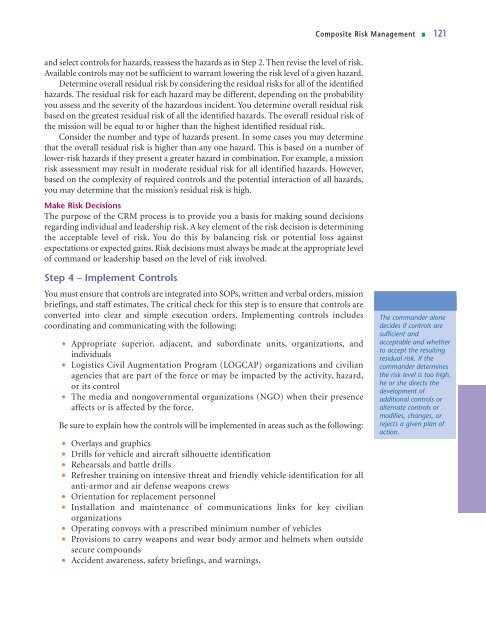Composite Risk Management.pdf - UNC Charlotte Army ROTC
Composite Risk Management.pdf - UNC Charlotte Army ROTC
Composite Risk Management.pdf - UNC Charlotte Army ROTC
- No tags were found...
Create successful ePaper yourself
Turn your PDF publications into a flip-book with our unique Google optimized e-Paper software.
<strong>Composite</strong> <strong>Risk</strong> <strong>Management</strong> ■ 121and select controls for hazards, reassess the hazards as in Step 2. Then revise the level of risk.Available controls may not be sufficient to warrant lowering the risk level of a given hazard.Determine overall residual risk by considering the residual risks for all of the identifiedhazards. The residual risk for each hazard may be different, depending on the probabilityyou assess and the severity of the hazardous incident. You determine overall residual riskbased on the greatest residual risk of all the identified hazards. The overall residual risk ofthe mission will be equal to or higher than the highest identified residual risk.Consider the number and type of hazards present. In some cases you may determinethat the overall residual risk is higher than any one hazard. This is based on a number oflower-risk hazards if they present a greater hazard in combination. For example, a missionrisk assessment may result in moderate residual risk for all identified hazards. However,based on the complexity of required controls and the potential interaction of all hazards,you may determine that the mission’s residual risk is high.Make <strong>Risk</strong> DecisionsThe purpose of the CRM process is to provide you a basis for making sound decisionsregarding individual and leadership risk. A key element of the risk decision is determiningthe acceptable level of risk. You do this by balancing risk or potential loss againstexpectations or expected gains. <strong>Risk</strong> decisions must always be made at the appropriate levelof command or leadership based on the level of risk involved.Step 4 – Implement ControlsYou must ensure that controls are integrated into SOPs, written and verbal orders, missionbriefings, and staff estimates. The critical check for this step is to ensure that controls areconverted into clear and simple execution orders. Implementing controls includescoordinating and communicating with the following:• Appropriate superior, adjacent, and subordinate units, organizations, andindividuals• Logistics Civil Augmentation Program (LOGCAP) organizations and civilianagencies that are part of the force or may be impacted by the activity, hazard,or its control• The media and nongovernmental organizations (NGO) when their presenceaffects or is affected by the force.Be sure to explain how the controls will be implemented in areas such as the following:• Overlays and graphics• Drills for vehicle and aircraft silhouette identification• Rehearsals and battle drills• Refresher training on intensive threat and friendly vehicle identification for allanti-armor and air defense weapons crews• Orientation for replacement personnel• Installation and maintenance of communications links for key civilianorganizations• Operating convoys with a prescribed minimum number of vehicles• Provisions to carry weapons and wear body armor and helmets when outsidesecure compounds• Accident awareness, safety briefings, and warnings.The commander alonedecides if controls aresufficient andacceptable and whetherto accept the resultingresidual risk. If thecommander determinesthe risk level is too high,he or she directs thedevelopment ofadditional controls oralternate controls ormodifies, changes, orrejects a given plan ofaction.
















